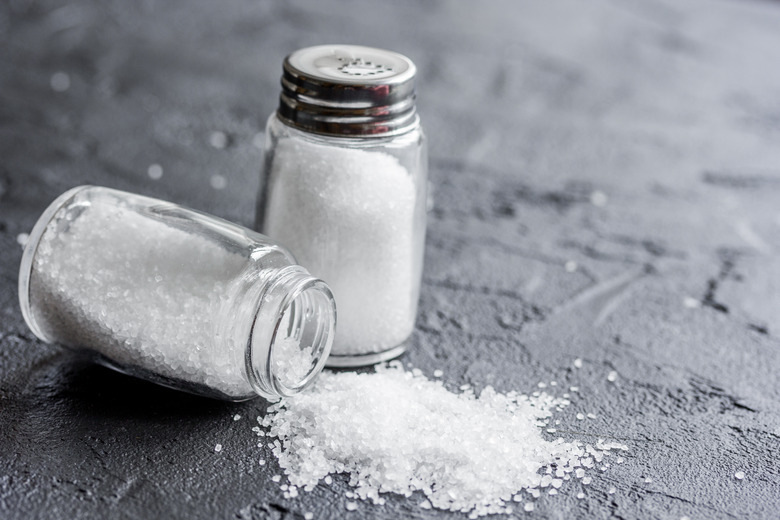What Happens To Atoms During A Chemical Reaction?
Chemical reactions take place when the atoms of two or more substances exchange or share electrons. The reaction produces atoms and molecules with the electrons arranged differently. The changed configuration of the atoms involves a change in energy, meaning the chemical reaction either gives off or absorbs light, heat or electricity. In turn, to separate the atoms into their original state, energy has to be removed or provided.
Chemical reactions govern many of the processes of daily life and can be exceedingly complicated, with both atoms and molecules entering a reaction and producing completely different combinations of atoms and molecules as products of the reaction. The different types of reactions and the way electrons are exchanged or shared can produce such different products as plastics, medicines and detergents.
TL;DR (Too Long; Didn't Read)
During a chemical reaction, the atoms of the original substances gain, lose or share their electrons with those of the substances with which they are reacting. The reaction creates new substances made up of a new combination of atoms and a different configuration of electrons.
Atoms in a Chemical Reaction
Atoms in a Chemical Reaction
Atoms consist of a nucleus and surrounding electrons. The electrons arrange themselves in shells around the nucleus, and each shell has room for a fixed number of electrons. For example, the innermost shell of an atom has room for two electrons. The next shell has room for eight. The third shell has three subshells that have room for two, six and 10 electrons. Only the electrons in the outermost shell, or the valence shell, take part in chemical reactions.
An atom always starts out with a fixed number of electrons, given by the atomic number. The electrons of the atomic number fill the electron shells from the inside out, leaving the remaining electrons in the outside shell. The electrons in the outside valence shell determine how an atom behaves, whether taking, giving or sharing electrons to take part in chemical reactions and to form two types of chemical bonds: ionic and covalent.
Ionic Bonds
Ionic Bonds
Atoms are most stable when their valence electron shells are full. Depending on the atom's atomic number, that can mean having two, eight or more electrons in the outside shell. One way to complete shells is for atoms that have one or two electrons in their valence shell to donate them to atoms that are missing one or two in their outermost shell. Such chemical reactions involve the exchange of electrons between two or more atoms with the resulting substance made up of two or more ions.
For example, sodium has an atomic number of 11, meaning the innermost shell has two electrons; the next shell has eight, and the outermost valence shell has one. Sodium could have a complete outermost shell if it donated its extra electron. Chlorine, on the other hand, has an atomic number of 17. This means it has two electrons in its inner shell, eight in the next shell, two in the next subshell, and five in the outermost subshell where there is room for six. Chlorine can complete its outermost shell by accepting an extra electron.
In fact, sodium and chlorine react with a bright yellow flame to form a new compound, sodium chloride or table salt. In that chemical reaction, each sodium atom gives its single outside electron to a chlorine atom. The sodium atom becomes a positively charged ion, and the chlorine atom becomes negatively charged. The two differently charged ions attract to form the stable sodium chloride molecule with an ionic bond.
Covalent Bonds
Covalent Bonds
Many atoms have more than one or two electrons in their valence shell, but giving up three or four electrons could make the remaining atom unstable. Instead, such atoms enter a sharing arrangement with other atoms to form a covalent bond.
For example, carbon has atomic number six, which means it has two electrons in its inner shell and four in the second shell with room for eight. In theory, a carbon atom could give up its four outermost electrons or receive four electrons to complete its outermost shell and form an ionic bond. In practice, a carbon atom forms a covalent bond with other atoms that can share electrons, such as the hydrogen atom.
In methane, a single carbon atom shares its four electrons with four hydrogen atoms, each with a single shared electron. Sharing means that eight electrons are distributed over the carbon and hydrogen atoms such that different shells are full at different times. Methane is an example of a stable covalent bond.
Depending on the atoms involved, chemical reactions can result in many combinations of bonds as electrons are transferred and shared in various stable arrangements. Two of the most important features of a chemical reaction are the changed electron configurations and the stability of the reaction's products.
Cite This Article
MLA
Markgraf, Bert. "What Happens To Atoms During A Chemical Reaction?" sciencing.com, https://www.sciencing.com/what-happens-to-atoms-during-a-chemical-reaction-13710467/. 19 March 2018.
APA
Markgraf, Bert. (2018, March 19). What Happens To Atoms During A Chemical Reaction?. sciencing.com. Retrieved from https://www.sciencing.com/what-happens-to-atoms-during-a-chemical-reaction-13710467/
Chicago
Markgraf, Bert. What Happens To Atoms During A Chemical Reaction? last modified August 30, 2022. https://www.sciencing.com/what-happens-to-atoms-during-a-chemical-reaction-13710467/
